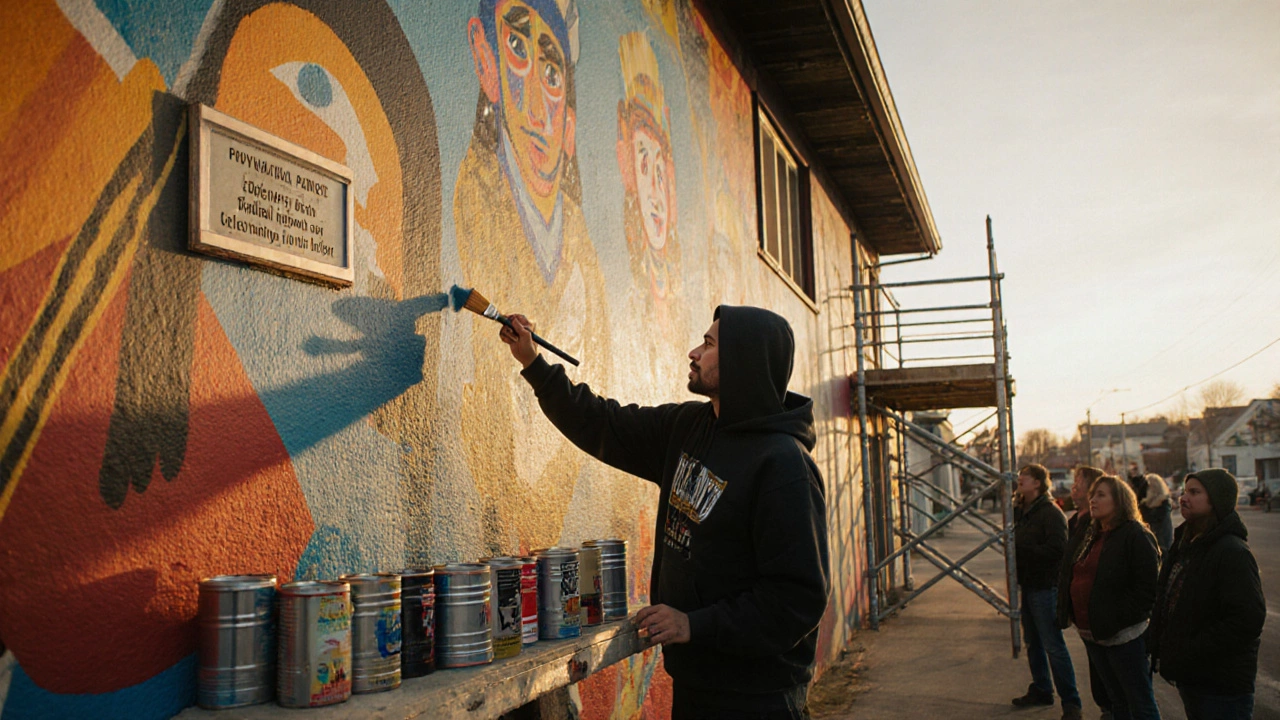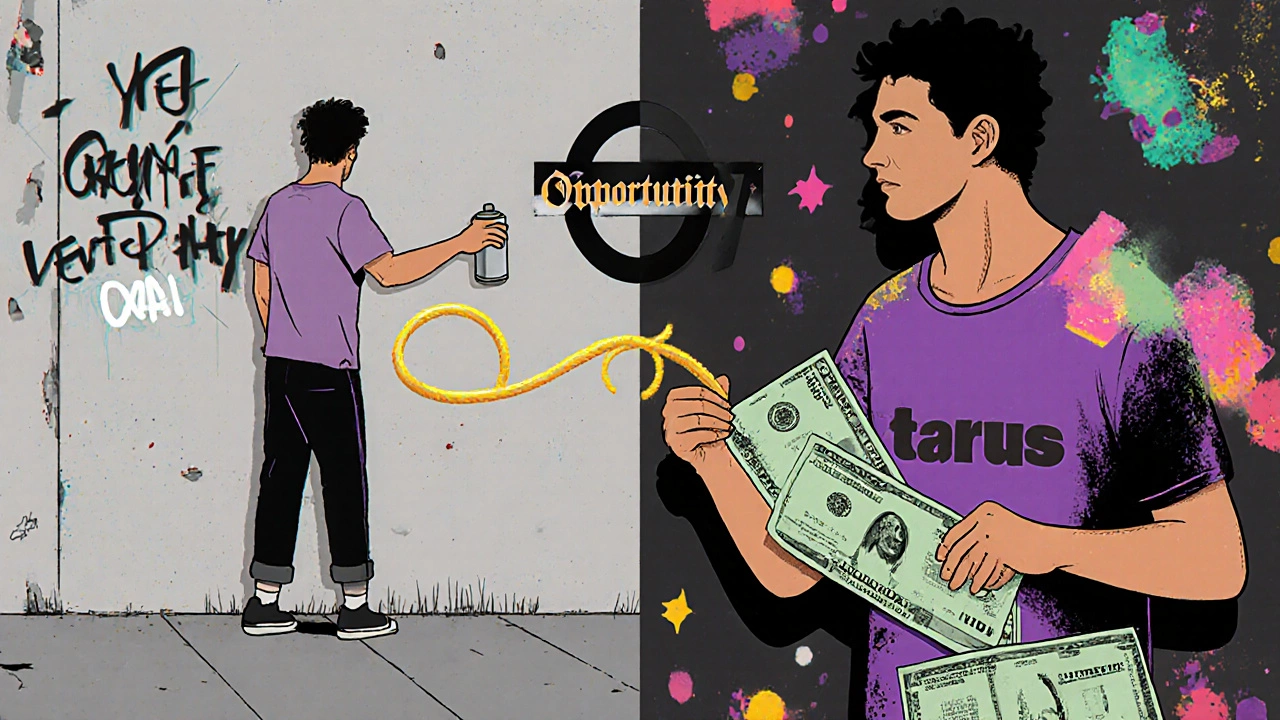Street Artist Income Calculator
Choose Your Income Stream
Select an income type and fill in details to see estimated earnings
Street art isn’t just graffiti on walls-it’s murals that turn alleyways into galleries, stencils that spark conversations, and murals commissioned by cities to revitalize neighborhoods. But here’s the real question: do street artists get paid? The answer isn’t simple. Some make six figures. Others scrape by selling prints online. Most fall somewhere in between.
Most street artists don’t get paid for the art on the wall
Let’s be clear: if you’re tagging a train or slapping up a sticker in the middle of the night, you’re not getting a check. That’s illegal. And in most cities, that kind of work doesn’t come with payment. Even if your piece goes viral, the city won’t send you a thank-you note-or a payment. The law doesn’t recognize unauthorized street art as a service. It’s vandalism, plain and simple.
But here’s where it gets interesting. Once your work gains attention, things change. A mural you painted illegally on a brick wall in Berlin might get covered in protective varnish. A photo of it gets shared by a major magazine. Then, out of nowhere, a local business owner asks if you’d paint their building. That’s when the money starts.
Commissioned murals are the main way street artists earn
The real income for most professional street artists comes from commissions. Cities hire them. Businesses hire them. Developers hire them. In Vancouver, the Downtown Eastside has over 40 official murals funded by the city’s public art program. Artists are paid between $5,000 and $25,000 per mural, depending on size, location, and complexity.
It’s not just big cities. Small towns are doing it too. In 2024, a town in Manitoba paid a local artist $12,000 to paint a 60-foot mural celebrating Indigenous history. The project was funded through a provincial arts grant. The artist spent three weeks on-site, bought paint, rented scaffolding, and got paid in full before the first brushstroke.
These commissions usually come with contracts. The artist owns the copyright. The client owns the wall. The artist gets to sign their name. And yes-they get paid upfront.
Corporate sponsorships and brand deals are growing
Big brands are catching on. In 2023, Nike partnered with 12 street artists across North America to create limited-edition sneakers inspired by local murals. Each artist received $15,000 plus a percentage of sales from their design. That’s not just a paycheck-it’s exposure to millions.
Other companies hire street artists for product launches. A craft beer brand in Toronto hired three artists to paint a warehouse wall with their logo and flavor themes. The artists were paid $8,000 each and got free beer for a year. Not bad.
But there’s a catch. Brands want control. They’ll ask you to change your style. They’ll insist on using their colors. Some artists say yes. Others walk away. The best ones negotiate: “I’ll use your palette, but I keep creative freedom on composition.”

Selling prints and merchandise keeps the lights on
Not every artist gets a city commission. But almost all of them sell prints. A high-quality giclée print of a popular mural can sell for $150 to $600. Artists sell them online through Etsy, their own websites, or pop-up shops at art fairs.
One artist from Montreal sells over 300 prints a year. His most popular piece? A black-and-white portrait of a woman holding a maple leaf, painted on a side street in Little Italy. He made $42,000 from prints in 2024. He never got paid to paint the original-but he made more from copies than most muralists earn from commissions.
Merchandise helps too. T-shirts, stickers, tote bags. A simple design on a $25 shirt can turn into $10,000 in annual revenue if it catches on. One artist in Portland sells 500 shirts a year of a cartoon raccoon holding a spray can. He didn’t paint the raccoon on a wall-he painted it on a shirt first. Now the wall version is his most requested mural.
Grants, residencies, and public funding
There’s money out there if you know where to look. Arts councils in Canada, the U.S., and Europe offer grants for public art. The Canada Council for the Arts gives out over $10 million annually to public art projects. Artists apply with proposals: where they’ll paint, who it’s for, how it connects to the community.
Residencies are another path. In 2025, the Vancouver Public Art Program offered a six-week residency for street artists. Selected artists got $10,000, studio space, materials, and help with permits. They painted a 120-foot wall in a low-income neighborhood. The city promoted it as a tourism draw. The artist? Paid. No strings attached.
Don’t forget: some artists get paid just to leave walls alone
It sounds weird, but it’s real. Property owners sometimes pay artists to paint their walls-so they don’t get tagged by others. In New York, a landlord in Brooklyn paid a well-known artist $3,000 to cover a graffiti-covered building with a colorful mural. The result? No more tags. No more fines. Just art.
This is called “art as vandalism prevention.” It’s common in cities with high graffiti rates. The artist doesn’t just get paid-they get respect. And sometimes, a long-term contract.

What doesn’t pay: social media followers
Having 500,000 Instagram followers doesn’t mean you’re making money. Not unless you’re selling something. A lot of street artists post daily updates. They get likes. They get shares. But no one pays them.
One artist in Austin posted a video of her painting a 30-foot mural. It got 8 million views. She got DMs from brands. She got offers. But only one paid her-$5,000 to create a similar piece for their new store. The rest? Asked for free exposure.
Followers are not income. Sales are.
How to start getting paid as a street artist
If you’re serious about turning street art into income, here’s what actually works:
- Build a portfolio of your best work-even if it’s illegal. Take high-res photos. Document the process.
- Apply for public art grants. Check your city’s arts council website. Deadlines are usually in January and July.
- Reach out to local businesses. Offer to paint their wall for a flat fee. Bring your portfolio. Be professional.
- Sell prints. Use print-on-demand services like Printful or Redbubble. Set up a simple website with Square or Shopify.
- Network. Go to art fairs. Talk to gallery owners. Join artist collectives. Relationships lead to paid work.
There’s no magic formula. But if you treat your art like a business, the money follows.
It’s not about the wall-it’s about the opportunity
Street art doesn’t pay because it’s on the street. It pays because it’s seen. Because it moves people. Because it turns a blank wall into a landmark.
The artists who earn the most aren’t the ones with the loudest tags. They’re the ones who understand that the wall is just the beginning. The real canvas is the conversation it starts. And that’s something you can sell.
Do street artists get paid for graffiti?
No, not for unauthorized graffiti. If you spray-paint without permission, it’s illegal, and you won’t get paid-even if your work becomes famous. Payment only comes when the art is commissioned, licensed, or part of a legal project like a public mural or brand collaboration.
How much do mural artists make per project?
Mural artists typically earn between $5,000 and $25,000 per project, depending on size, location, and complexity. In major cities like Vancouver or Toronto, public commissions often pay $10,000-$20,000 for large-scale works. Smaller murals or private commissions may pay $3,000-$8,000. Materials and labor are usually included in the fee.
Can street artists make a full-time living?
Yes, but not from walls alone. Most full-time street artists combine commissions, print sales, merchandise, grants, and teaching workshops. One artist in Montreal makes $80,000 a year-half from murals, half from prints and shirts. It takes years to build, but it’s possible with discipline and smart branding.
Do cities pay for street art?
Yes, many cities now fund street art as part of urban renewal, tourism, or cultural programs. Vancouver, Berlin, Melbourne, and Philadelphia all have public art budgets that hire artists for murals. These projects are competitive-artists submit proposals, and selected ones get paid upfront with permits and insurance covered.
What’s the difference between street art and graffiti?
Graffiti is usually word-based, done quickly, and often unauthorized. Street art is image-based, planned, and often commissioned. Street art includes murals, stencils, wheatpaste, and installations. While both can be illegal, street art is more likely to be legally paid for because it’s seen as public decoration, not vandalism.


